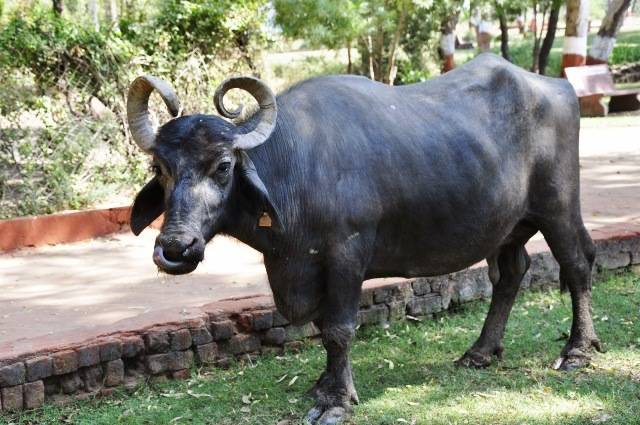
Buffaloes also called as Bubalus bublis belong to the family bovidae, sub-family bovinae, genus bubalis and species arni or the wild Indian buffalo. They are classified into river and swamp types. The present day domesticated buffaloes are the descendants of Bos arni found in North-Eastern parts of India especially in Assam and surrounding areas.
Buffaloes are believed to have been domesticated around 5000 years ago in the Indus Valley and thrive best in the areas of moderate rainfall as they require plenty of water for their daily bath. Indian buffaloes are considered to be an important source of milk today. They yield nearly three times milk like cows. Interestingly, 47.22 million milch buffaloes produce 55 percent of milk which is more than half of the total milk produced in the country. Whereas, 57 million cows contribute only 45 percent of the total milk yield.
The most Important Breeds of Buffaloes are as follows:
1. Murrah
-
Murrah is the most important breed of buffaloes also called Delhi, Kundi and Kali.
-
Its home is Rohtak, Hisar and Sind of Haryana, Nabha and Patiala districts of Punjab and Southern parts of Delhi.
-
Its color is usually jet black with white markings on the tail, face and extremities.
-
The average milk yield per lactation is 1,500- 2,500 kg.
-
The age of first calving is 45-50 months in villages and in good herds, it is 36-40 months.
-
It is the most efficient milk and butterfat producer in India.

2. Jaffrabadi
-
It is the heaviest Indian breed of buffalo.
-
It is found in Gir forests, Kutch, and Jamnagar districts of Gujarat.
-
The color is usually black with a long body and heavy horns.
-
The average milk yield is 1000-1200 kg per lactation.
-
The bullocks are heavy and are used for plowing and carting.
3. Surti
-
They are also known as Deccani, Gujarati, Talabda, Charator, and Nadiadi.
-
Its breeding tract is Kaira and Baroda districts of Gujarat.
-
Its color is either black or brown with a well-shaped and medium-sized body.
-
The peculiarity of it is that it produces a very high-fat percentage of milk (8-12 per cent).
-
It has two white collars- one round the jaw and other at the brisket.
4. Nili Ravi
-
Its breeding tract is Satluj Valley in Ferozepur district of Punjab and the Sahiwal district of Pakistan.
-
Its head is small, elongated, bulging at top and depressed between eyes.
-
The peculiarity of this breed is that it has wall eyes. The horns are very small and tightly coiled.
-
The milk yield is 1,500-1,850 kg per lactation.
6. Nagpuri
-
It is also called as Elitchpuri or Barari.
-
Its breeding tract is Nagpur, Akola, Amravati districts of Mahrashtra.
-
It has long, flat and curved horns bending backwards on each side of the back.
-
These bullocks can be used for heavy work.
-
The average milk yield is 700-1,200 kg per lactation.
7. Mehsana
-
It is found in Mehsana, Sabarkanda, and Banaskanta districts in Gujarat and adjoining Maharashtra.
-
It is evolved out of cross-breeding between Surti and Murrah.
-
Its color is usually black to grey and its body is longer than Murrah but its limbs are lighter.
-
These bullocks are good for heavy work but are rather slow.
-
The milk yield is 1,200-1,500 kg per lactation.
8. Toda
-
It is named after its herdsmen, the Toda tribe of the Nilgiris in Tamil Nadu.
-
It is found in high rainfall and high humid area.
-
The predominant coat colors are fawn and ash grey with long horns which are variable in shape.
-
Its thick hair coat is found all over the body.
-
The body is long, deep with a deep chest having short and strong legs.
The average milk yield is 500 kg per lactation with a high fat content of 8 percent.

Chart Representing Indigenous Breeds of Buffaloes and Characteristics
Source- engormix.com
The population of Cattle and Buffaloes in India
Source- engormix.com
















